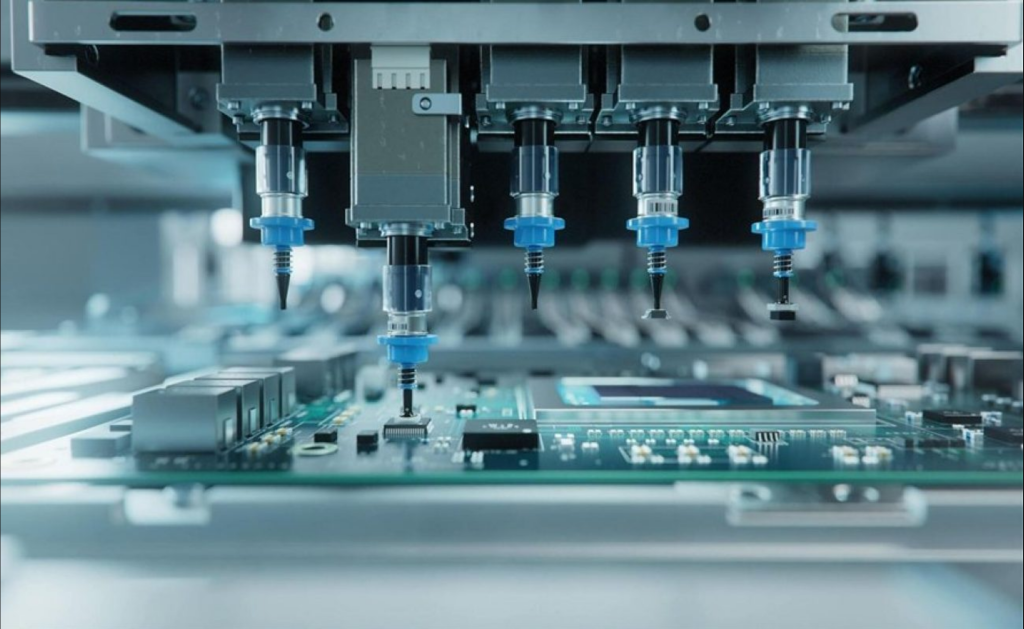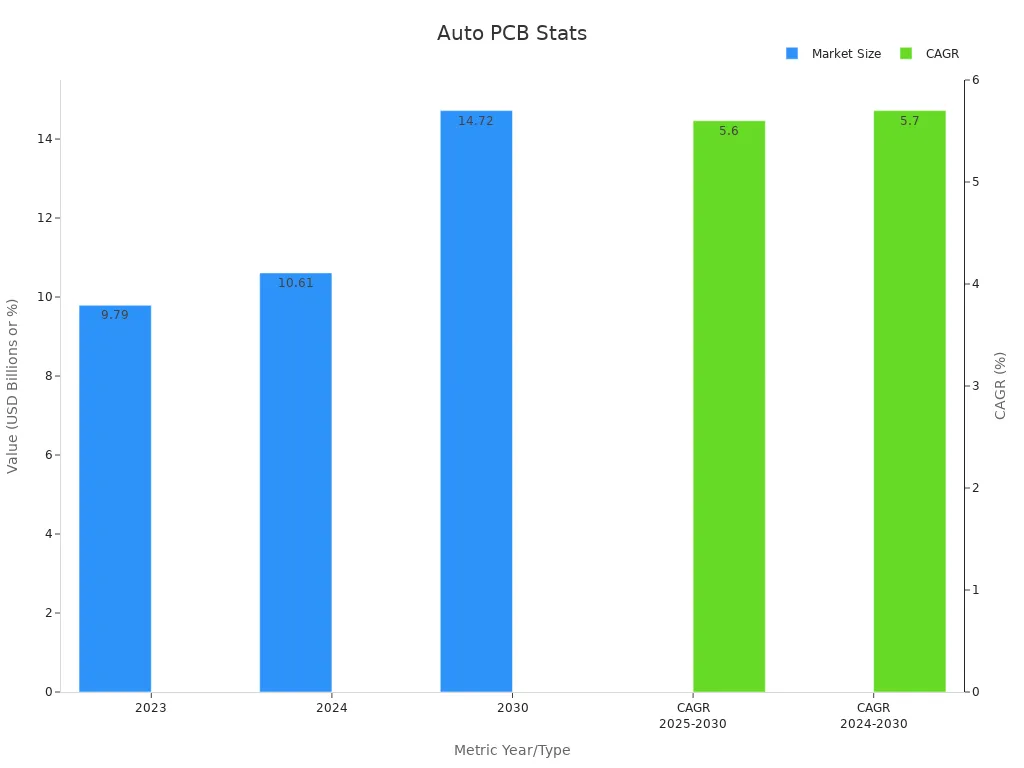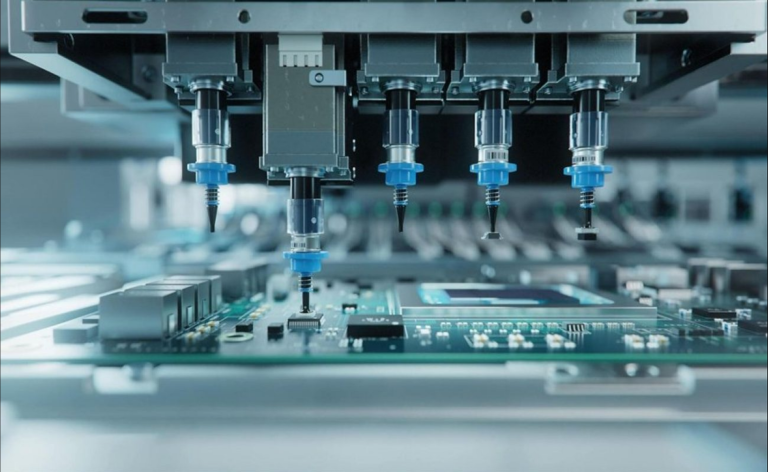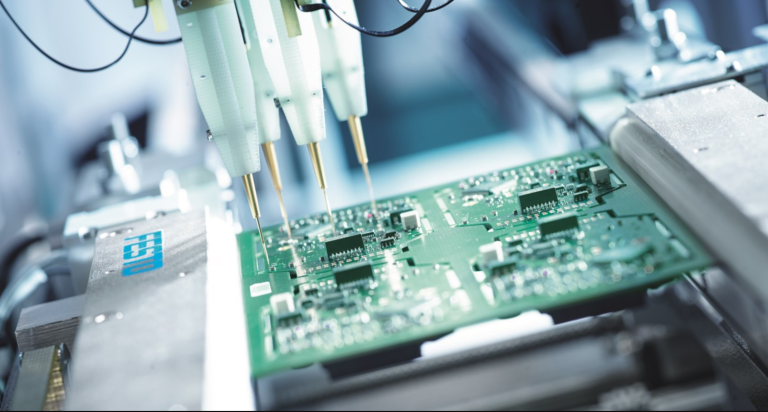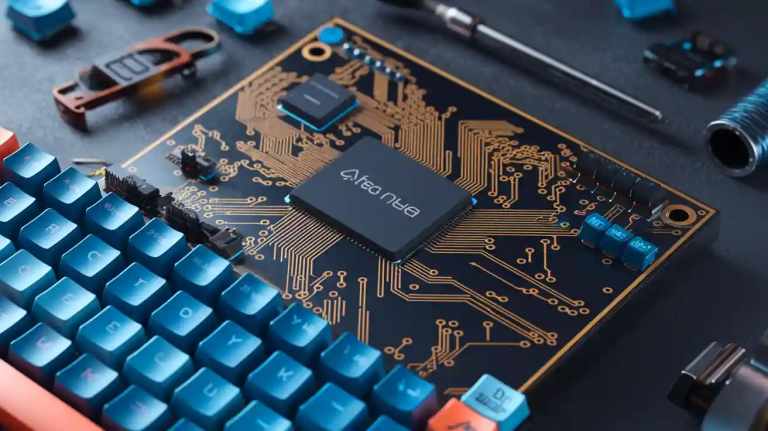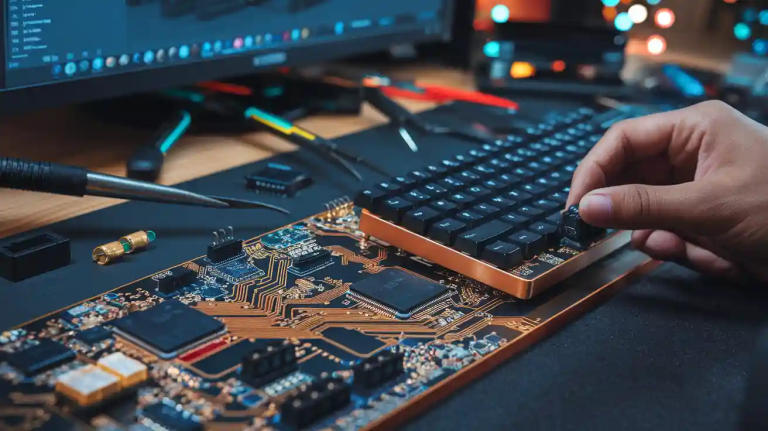Automotive PCBs in 2025 redefine durability and performance. These printed circuit boards are designed to thrive in the harshest environments, enduring extreme temperature ranges from -40°F to 257°F and resisting vibrations up to 50g. This resilience stems from rigorous testing, including thermal cycling and vibration assessments, which ensure their reliability under real-world conditions. As the demand for robust automotive electronics grows, PCBs continue to meet strict safety standards while maintaining optimal functionality. Whether in freezing climates or high-heat engine compartments, these PCBs deliver unmatched reliability, making them indispensable in modern automotive systems.
Key Takeaways
- Car PCBs are made to last through tough conditions.
- They can handle temperatures from -40°F to 257°F and strong shakes up to 50g.
- Special materials like ceramic and resin make them stronger and heatproof.
- Tests make sure car PCBs work well in real-life situations.
- Sensors now check for problems early, making car systems more reliable.
- Green designs and eco-friendly materials help the planet and keep performance high.
Key Factors Behind the Reliability of Automotive PCBs
Advanced Materials and Design
Use of heat-resistant substrates and high-Tg materials.
The materials used in automotive PCBs play a critical role in their reliability. High-Tg (glass transition temperature) materials and heat-resistant substrates ensure that these printed circuit boards can withstand extreme temperature fluctuations. For instance, ceramic-based PCBs offer exceptional thermal stability, making them ideal for high-heat environments like engine systems. Organic resin-based PCBs, while more cost-effective, also provide increased heat resistance, making them suitable for most modern vehicles.
| Material Type | Key Properties | Applications |
|---|---|---|
| Ceramic-based PCBs | High heat resistance, excellent stability | Engine systems in high-thermal environments |
| Organic resin-based PCBs | Increased heat resistance, lower cost | Majority of modern vehicles |
These advanced materials ensure that automotive PCBs maintain their performance and durability even under the most demanding conditions.
Multilayer designs and thermal management features.
Modern automotive PCBs often feature multilayer designs that enhance their functionality and reliability. These designs allow for better integration of components, reducing the risk of failure. Thermal management features, such as heat sinks and advanced coatings, further improve the PCB’s ability to dissipate heat. This ensures consistent performance in high-temperature environments, such as engine compartments or braking systems.
Rigorous Testing and Standards
Thermal cycling, vibration, and shock tests.
Automotive PCBs undergo rigorous testing to ensure their reliability in real-world conditions. Thermal cycling tests simulate temperature fluctuations, while thermal shock tests evaluate the PCB’s response to sudden changes in temperature. Vibration testing assesses the PCB’s resilience against mechanical vibrations, which are common in automotive applications. These tests identify potential weaknesses and ensure that the PCBs can withstand environmental challenges.
- ISO 26262: Ensures rigorous safety analysis for automotive PCBs, identifying hazards and implementing risk mitigation measures.
- IPC-6012DA: Provides requirements for manufacturing and performance, ensuring reliability and robustness of automotive PCBs.
- AEC-Q100 to AEC-Q200: Establish uniform testing protocols for electronic components, ensuring consistent performance under stress conditions.
Compliance with ISO 16750 and IPC-6012DA standards.
Adherence to industry standards is another key factor in the reliability of automotive PCBs. Standards like ISO 16750 and IPC-6012DA set stringent requirements for the design, manufacturing, and performance of PCBs. These standards ensure that the PCBs can endure the harsh conditions of automotive environments, including extreme temperatures, vibrations, and exposure to chemicals. By meeting these standards, manufacturers guarantee the durability and reliability of their products in automotive electronic systems.
Performance of Automotive PCBs in Extreme Conditions
Temperature Resilience
Thermal management solutions like heat sinks and advanced coatings.
Automotive PCBs excel in managing extreme temperatures due to innovative thermal management solutions. Heat sinks, for instance, dissipate excess heat generated by electronic components, ensuring stable operation. Advanced coatings, such as thermal interface materials, further enhance heat transfer efficiency. These features allow PCBs to maintain optimal performance even in high-temperature environments.
Performance in high-heat engine compartments and freezing climates.
Automotive PCBs are designed to operate reliably across a wide temperature range. Whether exposed to the intense heat of engine compartments or the freezing conditions of cold climates, these PCBs deliver consistent performance. The table below highlights the temperature tolerances for different vehicle sections:
| Vehicle Section | Low Temperature | High Temperature |
|---|---|---|
| Within vehicle body | -40°C | 85°C |
| Vehicle chassis below | -40°C | 125°C |
| Above engine | -40°C | 145°C |
| Transmission parts | -40°C | 155°C |
| Within engine | -40°C | 165°C |
These figures demonstrate the exceptional temperature resilience of automotive PCBs, meeting stringent industry standards like AEC-Q100 and AEC-Q200.
Vibration and Shock Resistance
Reinforced structures and flexible PCB designs.
Automotive PCBs face constant vibrations, especially in engines and off-road vehicles. Reinforced structures and flexible PCB designs enhance their durability. Flexible PCBs, in particular, absorb mechanical stress, reducing the risk of solder joint fatigue and trace cracking.
Durability in high-vibration environments like engines and off-road vehicles.
Vibration testing ensures that automotive PCBs can withstand the mechanical stresses of real-world conditions. During testing, PCBs are subjected to controlled vibrations to evaluate the integrity of solder joints and components. This process identifies potential failure points, enabling manufacturers to optimize designs for long-term reliability.
Protection Against Moisture and Corrosion
Conformal coatings and sealed enclosures.
Moisture and corrosion pose significant challenges to automotive PCBs. Conformal coatings, such as silicone or acrylic, create a protective barrier against environmental factors. Sealed enclosures further enhance protection by preventing water ingress and chemical exposure.
Resistance to chemicals, road salts, and humidity.
Automotive PCBs are engineered to resist harsh substances like road salts and chemicals. Parylene coatings, for example, offer excellent protection against moisture and corrosion. These coatings ensure that PCBs maintain their performance properties even in the most challenging environments.
| Protection Method | Protection Barrier | Hydrophobic | Thickness | Protection Against Water | Salt/Chemical Protection | Durability | Submersion Test Time to Failure |
|---|---|---|---|---|---|---|---|
| Unprotected PCB | None | No | N.A. | Poor | Poor | Low | Seconds (IP Rating N.A.) |
| Mechanical Seal | Good | No | Millimeters | Good – Ingress Poor – Penetration | Poor | Varies | Varies |
| Silicone/Acrylic Coatings | Good | Yes | μm – Millimeters | Good | Varies | Varies | Varies |
| Parylene Coating | Excellent | Partial | 2μm – 50μm | Excellent | Excellent | High | Days to Weeks (IPX7 – IPX8) |
These protective measures ensure that automotive PCBs meet the reliability requirements of modern vehicles, even under extreme environmental challenges.
Innovations Enhancing Automotive PCB Performance in 2025
Cutting-Edge Materials
Introduction of ceramic-based PCBs for high thermal stability.
Ceramic-based PCBs are revolutionizing automotive applications by offering unmatched thermal stability. These PCBs, made from high-temperature co-fired alumina and aluminum nitride, excel in environments with extreme temperature variations. Their high heat resistance makes them ideal for engine systems, where maintaining performance under thermal stress is critical. Additionally, their excellent dimensional stability ensures reliability over the long service life of automotive electronics, which often spans 10 to 12 years.
Use of nanotechnology to enhance durability and performance.
Nanotechnology is transforming the durability and performance of PCBs in automotive applications. By incorporating nanoscale materials, manufacturers enhance the mechanical strength and thermal conductivity of PCBs. This innovation reduces the risk of failure in harsh environments, such as high-vibration or high-temperature areas. Furthermore, AI-powered PCB design, which leverages nanotechnology, minimizes manufacturing defects and improves energy efficiency, aligning with the industry’s push for lightweight and miniaturized components.
Smart Features for Reliability
Integration of sensors for real-time monitoring.
Modern automotive PCBs now integrate sensors that provide real-time monitoring of critical parameters like temperature, vibration, and humidity. These sensors enable you to detect potential issues before they escalate, ensuring the reliability of electronic systems. For example, in electric vehicles, these sensors monitor battery health, optimizing performance and extending lifespan.
Self-diagnostic capabilities to predict and prevent failures.
Self-diagnostic features in PCBs are a game-changer for automotive applications. These systems analyze data from integrated sensors to predict potential failures. By identifying issues early, they help you avoid costly repairs and ensure the durability of your vehicle’s electronic systems. This proactive approach enhances safety and aligns with stringent automotive standards.
Eco-Friendly and Efficient Designs
Use of sustainable materials and manufacturing processes.
The automotive industry is increasingly adopting eco-friendly PCB materials, such as lead-free and recyclable options. These materials reduce environmental impact while maintaining high performance. Sustainable manufacturing processes further support this initiative, ensuring that automotive PCBs meet both performance and environmental standards.
Energy-efficient designs for electric and hybrid vehicles.
Energy efficiency is a top priority in the design of PCBs for electric and hybrid vehicles. Lightweight and miniaturized PCBs contribute to improved fuel efficiency by reducing the overall weight of electronic control units (ECUs). Over the years, the volume of ECUs has decreased significantly, from 1,200 cm³ to sizes four times smaller. This trend not only saves energy but also aligns with the industry’s focus on sustainability.
These innovations in materials, smart features, and eco-friendly designs ensure that automotive PCBs continue to meet the demands of modern vehicles while addressing environmental challenges.
Automotive PCBs in 2025 redefine durability and reliability for automotive applications. These PCBs are engineered to endure extreme temperature variations, vibrations, and environmental challenges, ensuring consistent performance across diverse climates. With advancements in materials like metal-core PCBs and compliance with rigorous testing standards such as ISO 26262 and IPC-6012DA, you can trust their ability to meet the demands of modern vehicles.
- Key highlights of automotive PCBs:
- Designed for a service life of 10 to 12 years, matching vehicle longevity.
- Enhanced by AI integration for real-time decision-making in autonomous systems.
- Essential for the growing demand in electric and hybrid vehicles.
The future of automotive PCBs looks promising, driven by innovations in materials, smart features, and eco-friendly designs. As electric vehicles and advanced driver-assistance systems (ADAS) continue to grow, these PCBs will play a pivotal role in shaping the next generation of automotive technology.
FAQ
What makes automotive PCBs safe for extreme conditions?
Automotive PCBs use advanced materials and designs to ensure safety in extreme environments. They undergo rigorous testing for temperature, vibration, and shock resistance. These safety features guarantee reliable performance in high-heat engine compartments and freezing climates.
How do automotive PCBs ensure functional safety?
Automotive PCBs comply with strict standards like ISO 26262, which focuses on functional safety. They integrate self-diagnostic capabilities and real-time monitoring sensors to detect and prevent potential failures, ensuring the safety of critical automotive systems.
Can automotive PCBs resist moisture and corrosion?
Yes, automotive PCBs feature conformal coatings and sealed enclosures to protect against moisture and corrosion. These safety features shield the PCBs from road salts, chemicals, and humidity, ensuring long-term durability.
Are automotive PCBs eco-friendly?
Manufacturers now use sustainable materials and energy-efficient designs for automotive PCBs. These eco-friendly practices reduce environmental impact while maintaining high performance, especially in electric and hybrid vehicles.
How do automotive PCBs handle vibrations in vehicles?
Reinforced structures and flexible PCB designs absorb mechanical stress, making them highly resistant to vibrations. This durability ensures reliable performance in high-vibration environments like engines and off-road vehicles.



